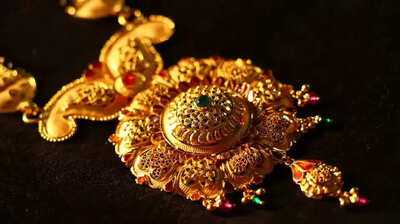In India, gold is more than just a precious metal — it is a symbol of faith, emotion, and tradition. Whether it’s a wedding, festival, or any special occasion, buying gold has become a cultural ritual. Currently, gold prices have crossed ₹1.20 lakh per tola, making it one of the most expensive investments in households. However, what many people don’t know is that when gold jewellery is crafted, nearly 1 gram of gold is wasted for every 10 grams processed — a loss that ultimately impacts the buyer’s pocket.
Why Does Gold Get Wasted During Jewellery Making?Gold purity is measured in carats (Carat or “Karat”). Pure gold is 24 carat — extremely soft and unsuitable for crafting ornaments. To make jewellery stronger and more durable, jewellers mix other metals like copper, zinc, silver, or cadmium. This combination reduces the softness of gold but also decreases its purity, resulting in 22-carat or 18-carat gold jewellery.
According to Santosh, a jeweller from Warangal, Telangana, about 1 gram of gold gets lost during the processing of every 10 grams of 22-carat gold. For example, if you hand over 10 grams of gold to create a chain, the finished jewellery will actually weigh around 9 grams — but you’ll still pay the price for the full 10 grams. The lost portion is considered a part of the production process, as small amounts of gold stick to tools, melt off, or mix with other metals.
What Happens When You Exchange or Melt Old Jewellery?If you exchange your old ornaments, especially hallmarked jewellery, the wastage is slightly lower — around 1 gram or even less in some cases. When old pieces are melted down to make pure gold biscuits or bars, the non-gold metals mixed in the alloy burn off. As a result, the final weight of the refined gold is reduced.
Jewellers explain that this process ensures you get purer gold, but it also means a small loss in quantity. Therefore, when exchanging or refining gold, one must always ask for the purity certificate and check the weight difference before finalizing the deal.
Investment Tip: Melting Old Jewellery Can Be SmarterFrom an investment perspective, melting old jewellery into pure gold biscuits or bars can be more beneficial. It eliminates making charges and gives you high-purity gold, which is easier to store, sell, or pledge later. However, many people ignore the fine details of these calculations and end up bearing unnecessary losses during exchanges — especially when gold prices are around ₹14,000 per gram.
Experts recommend that buyers should always opt for BIS hallmarked gold, verify its purity, and understand the weight details before getting jewellery made or exchanged. This ensures that your hard-earned money retains its true shine, just like your gold.
You may also like

Is Chet Holmgren playing tonight vs Golden State Warriors? Latest update on the Oklahoma City Thunder star's injury report (November 11, 2025)

Anta Assembly bypoll: Rs 20.93 crore seized to ensure fair and secure polls

3I/ATLAS: Are these the most detailed images yet of our new interstellar visitor?

Eritrean asylum seeker attacks 3 police officers in migrant hotel rampage

Girl, 10, charged with rape and attempted murder of child, 5







